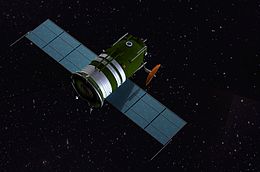Zond 3

Zond 3.
|
|||||||||||||||||||
| Mission type | Planetary Science | ||||||||||||||||||
|---|---|---|---|---|---|---|---|---|---|---|---|---|---|---|---|---|---|---|---|
| Operator | OKB-1 | ||||||||||||||||||
| COSPAR ID | 1965-056A | ||||||||||||||||||
| SATCAT no. | 01454 | ||||||||||||||||||
| Website | Zond 3 on NSSDC Master Catalog | ||||||||||||||||||
| Spacecraft properties | |||||||||||||||||||
| Manufacturer | OKB-1 | ||||||||||||||||||
| Launch mass | 960 kg (2,120 lb) | ||||||||||||||||||
| Start of mission | |||||||||||||||||||
| Launch date | 14:38, July 18, 1965--> | ||||||||||||||||||
| Rocket | Molniya SL-6/A-2-e | ||||||||||||||||||
| Launch site | Baikonur LC-1/5 | ||||||||||||||||||
| End of mission | |||||||||||||||||||
| Last contact | March 1966 | ||||||||||||||||||
| Orbital parameters | |||||||||||||||||||
| Reference system | Heliocentric | ||||||||||||||||||
| Semi-major axis | 1 AU | ||||||||||||||||||
| Eccentricity | 0.2683 | ||||||||||||||||||
| Perihelion | 0.9 AU | ||||||||||||||||||
| Apohelion | 1.56 AU | ||||||||||||||||||
| Inclination | 0.5° | ||||||||||||||||||
| Period | 500 days | ||||||||||||||||||
| Flyby of Moon | |||||||||||||||||||
| Closest approach | July 20, 1965 | ||||||||||||||||||
| Distance | 9,200 km (5,700 mi) | ||||||||||||||||||
|
|||||||||||||||||||
|
|
|||||||||||||||||||
| Instruments | |
|---|---|
| f/106 mm Camera and TV system with automatic inflight film processing | |
| Magnetometer | |
| Ultraviolet (0.25–0.35 µm and 0.19–0.27 µm) spectrograph | |
| Infrared (3–4 µm) spectrograph | |
| Radiation sensors (gas-discharge and scintillation counters) | |
| Radiotelescope | |
| Micrometeoroid instrument | |
| Experimental ion engine |
Zond 3 was a 1965 space probe intended to be sent toward Mars as a spacecraft test. It was a member of the Soviet Zond program sharing designation Zond, while being part of Mars 3MV project. It was unrelated to Zond spacecraft designed for manned circumlunar mission (Soyuz 7K-L1). Zond 3 completed a successful Lunar flyby, taking a number of good quality photographs for its time. It is believed that Zond 3 was initially designed as a companion spacecraft to Zond 2 to be launched to Mars during the 1964 launch window. The opportunity to launch was missed, and the spacecraft was launched on a Mars trajectory as a spacecraft test, even though Mars was no longer attainable.
Zond 3 was a repeat of a mission that failed in late 1963 intended to test communication at distances equivalent to the distances experienced by Mars and Earth. It passed by Earth's moon, the Moon, in 33 hours and communication ended when it was at a distance of 150 million kilometers from the Earth. The spacecraft was a 3MV-4 type and launched into space on a 8K78 Molniya rocket on July 18, 1965. It operated for 228 days, roughly equivalent to the time needed to survive a journey to Mars and exceeding that needed for Venus.
The Zond 3 took pictures of the Moon on film which were then scanned and returned by radio signal back to Earth; it took 25 exposures in visible light and three more for an ultraviolet spectrometer. The images it took could be re-transmitted, and the most distant re-transmission was on October 23, 1965 at a distance of 31.5 million km from the Earth.
The spacecraft design was similar to Zond 2, in addition to the imaging equipment it carried a magnetometer, ultraviolet (0.25 to 0.35 micrometre and 0.19 to 0.27 micrometre) and infrared (3 to 4 micrometre) spectrographs, radiation sensors (gas-discharge and scintillation counters), a radiotelescope and a micrometeoroid instrument. It also had an experimental ion engine.
...
Wikipedia
